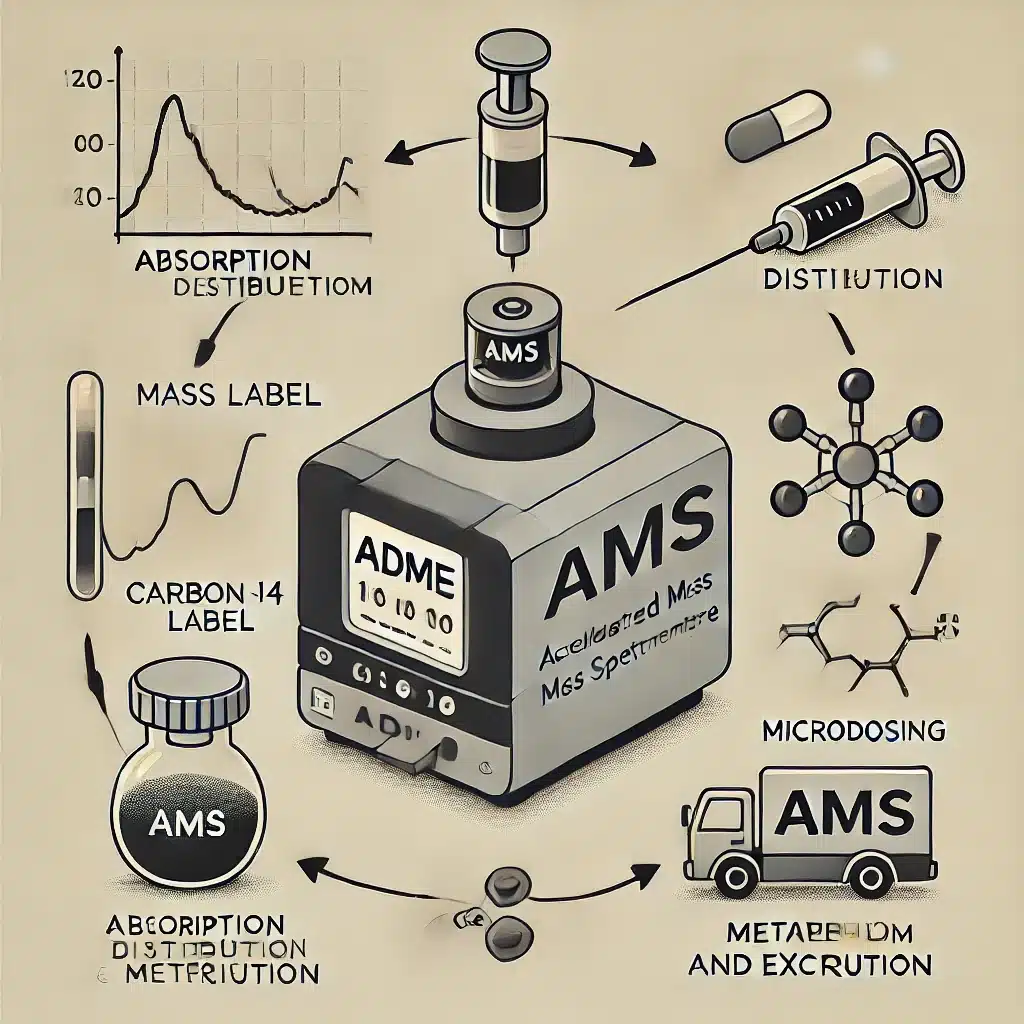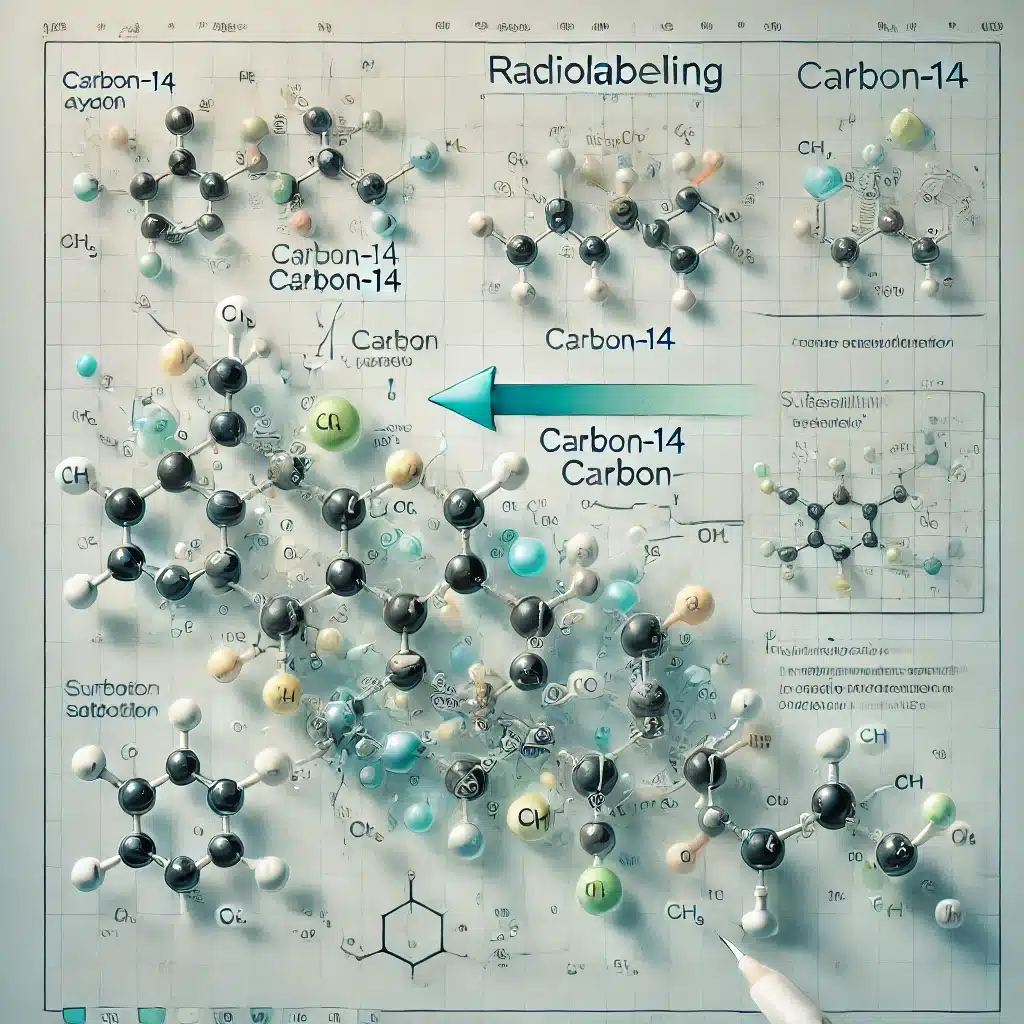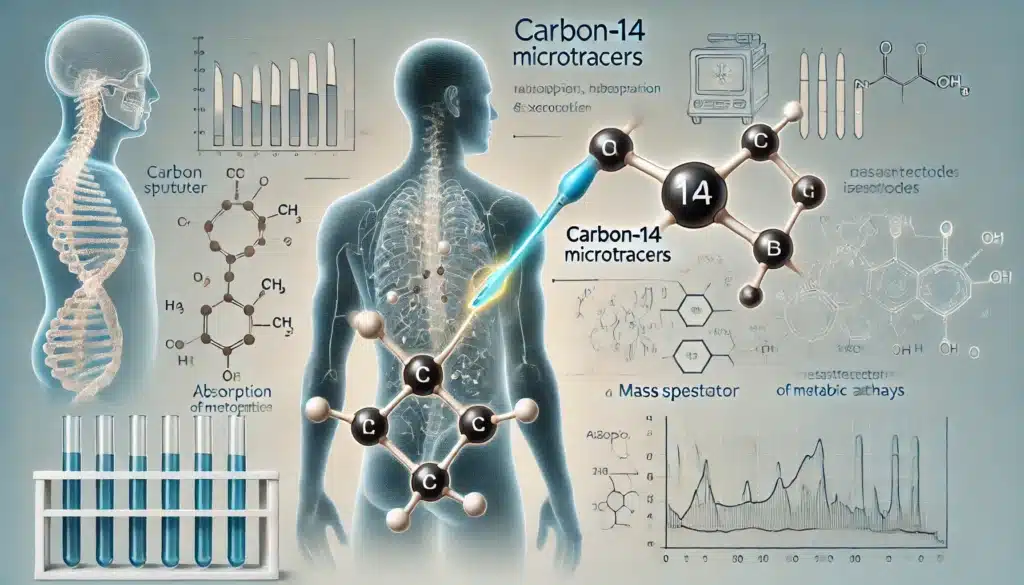Summary: Late-stage carbon-14 labelling and isotope exchange have gained significant attention due to their vital roles in drug development, environmental studies, and biochemistry. This article discusses recent advancements, key methodologies, and their implications in the field of radiochemistry. With increasing demands for efficient and selective labelling techniques, these methods offer robust solutions, aiding researchers in tracking complex molecules and analysing metabolic pathways with improved precision.
Introduction to Carbon-14
Radiolabelling with carbon-14 (14C) is crucial in the fields of medicinal chemistry, environmental sciences, and biochemical research. Carbon-14, a radioactive isotope of carbon with a half-life of approximately 5,730 years, enables researchers to trace and monitor molecules in various systems with minimal alteration to the original compound’s properties. Late-stage labelling and isotope exchange (IE) have emerged as innovative strategies to incorporate 14C into complex molecules with high specificity and efficiency. This article reviews current methods and advancements, offering insight into their applications and future potential.
Importance of Carbon-14 in Radiolabelling
Radiolabelling with carbon-14 offers several benefits due to the isotope’s properties:
- Long Half-Life: 14C has a half-life that is suitable for long-term studies, making it ideal for pharmacokinetic and toxicological investigations.
- Minimal Structural Disturbance: As a naturally occurring carbon isotope, 14C incorporation into molecules preserves the chemical properties, ensuring the labelled compound behaves similarly to its unlabelled counterpart.
- Versatility in Applications: Carbon-14 labelling is extensively used in studying metabolic pathways, drug distribution, and environmental contamination tracing.
Late-Stage Labelling: Concept and Benefits
Late-stage carbon-14 labelling refers to the introduction of the isotope into a complex molecule after its synthetic route has been largely completed. This method contrasts with traditional approaches, where isotopic labelling is conducted at the early stages of synthesis.
Key Benefits Include:
- Efficiency: Late-stage labelling circumvents the need for repeated synthesis and purification steps, making the process more time- and cost-effective.
- Applicability to Diverse Structures: This method allows for the labelling of molecules that are challenging to synthesise using conventional methods.
- Flexibility: Late-stage labelling techniques can be adapted to label different positions within a molecule, facilitating various metabolic and stability studies.
Methodologies in Late-Stage Carbon-14 Labelling
Recent advancements in late-stage carbon-14 labelling have led to the development of various efficient methods, which include:
Direct Carbon-14 Incorporation Techniques
Direct incorporation involves introducing 14C into a molecule using carbon-containing reagents. These techniques rely on late-stage transformations such as cross-coupling reactions, radical-mediated processes, or electrophilic substitution.
- Palladium-Catalysed Cross-Coupling Reactions: These have revolutionised the synthesis of complex labelled molecules. For example, Suzuki-Miyaura and Negishi coupling reactions can efficiently incorporate carbon-14 labelled moieties into aromatic systems. Researchers have optimised conditions to enhance the labelling yield and selectivity by choosing appropriate ligands and reaction parameters.
- Radical-Mediated Processes: These have been explored for incorporating 14C at difficult-to-access positions on molecules. Radical sources enable functionalisation under mild conditions, ensuring minimal decomposition of the target molecule.
Electrophilic and Nucleophilic Substitution
Electrophilic labelling often employs 14CO2 as a precursor, which can be inserted into substrates through reactions with organometallic intermediates or activated electrophiles. Nucleophilic substitution involves the displacement of leaving groups with 14C-labelled nucleophiles, such as [14C]-methyl iodide.
Challenges:
- Site Selectivity: Achieving selectivity in large, multifunctional molecules can be difficult, as competing reactions may reduce labelling efficiency.
- Reagent Availability: Specialised 14C-labelled reagents must be synthesised or procured, which can limit widespread application.
Isotope Exchange: Principles and Applications
Isotope exchange (IE) refers to the process where an atom within a molecule is replaced with its isotopic counterpart without altering the molecule’s structure. Carbon isotope exchange is particularly valuable for its ability to introduce 14C into specific positions without the need for de novo synthesis.
Mechanisms of Isotope Exchange
The mechanism of IE depends on the chemical environment of the targeted carbon atom. Common types of carbon isotope exchange reactions include:
- Carbon-Halogen Exchange: Utilising carbon-halogen bonds to facilitate the introduction of 14C in the presence of suitable catalysts.
- C-H Activation: A more sophisticated approach where carbon-hydrogen bonds are selectively activated and substituted with 14C under the influence of transition metal catalysts.
- Carbonyl Exchange: Carbon-14 can be introduced through the exchange of carbonyl groups in ketones, aldehydes, or esters using specialised labelling agents.
Advantages of Isotope Exchange
- Retention of Molecular Integrity: IE does not alter the overall structure of the compound, preserving its original biological or physical properties.
- Positional Labelling: Offers the ability to label specific carbon atoms within a molecule, which is particularly useful for metabolic tracing and mechanistic studies.
Notable Techniques:
- Transition Metal Catalysis: Transition metals such as palladium, rhodium, and iridium have been employed to catalyse isotope exchange reactions under mild conditions. Innovations in ligand design and catalyst development have improved the efficiency and selectivity of these processes.
- Photocatalytic Methods: Recent developments in photoredox catalysis have shown promise in promoting carbon isotope exchange with light-driven processes. This environmentally friendly approach minimises the need for harsh reagents or extreme conditions.
Applications in Drug Development and Metabolic Studies
Pharmacokinetics and ADME (Absorption, Distribution, Metabolism, and Excretion): Late-stage labelling and isotope exchange enable detailed analysis of how drugs are processed within the body. 14C-labelled drugs can be tracked to observe their absorption, distribution, metabolism, and excretion, helping pharmaceutical researchers ensure optimal drug design and efficacy.
Toxicology Studies: Carbon-14 labelled compounds are essential for assessing potential toxicological impacts. By tracing labelled metabolites, researchers can identify toxic by-products that may form during metabolism, contributing to safer drug development.
Biochemical Pathway Tracing: Labelling complex biological molecules with 14C facilitates the exploration of biochemical pathways. For example, 14C-labelled glucose or amino acids can be used to study metabolic flux and understand the distribution of carbon within an organism’s metabolic network.
Current Challenges and Limitations
Scalability: One of the main challenges in late-stage carbon-14 labelling and isotope exchange is the scalability of these techniques. The need for radiochemical infrastructure and safety protocols limits their application in larger-scale synthesis.
Complex Reaction Conditions: While advancements have been made in catalyst design and reaction conditions, some late-stage labelling processes require rigorous optimisation to achieve high yields and selectivity.
Cost of 14C Precursors: The cost of 14C-labelled precursors can be prohibitive, as specialised production facilities are required to handle radioactive materials.
Future Directions
The field of radiochemistry is rapidly evolving, and continued research is expected to bring about further improvements in late-stage carbon-14 labelling and isotope exchange. Promising areas include:
Green Chemistry Approaches: Developing environmentally friendly and sustainable methods for 14C incorporation, such as biocatalytic processes, could reduce the ecological impact of radiochemical synthesis.
Machine Learning for Reaction Optimisation: Applying artificial intelligence and machine learning algorithms to predict optimal reaction conditions could enhance the efficiency of labelling processes, reducing time and resources spent on trial and error.
Integration with Automated Platforms: Automating late-stage labelling and isotope exchange procedures will allow for higher throughput and more reproducible outcomes, paving the way for wider adoption in industrial and academic settings.
Enhanced Safety Protocols: Continued development of safety measures and containment systems will be crucial to expanding the availability of 14C labelling capabilities across laboratories without compromising worker health or safety.
Conclusion
Late-stage carbon-14 labelling and isotope exchange are transformative techniques that offer precise and efficient means of radiolabelling complex molecules. These methods have proven indispensable in the fields of drug development, toxicology, and metabolic studies, enabling researchers to track and study compounds with exceptional accuracy. While challenges remain, particularly in terms of scalability and cost, ongoing innovations promise to enhance these techniques’ robustness and accessibility. As radiochemical technologies advance, the potential for new applications and streamlined processes will continue to grow, cementing the importance of 14C labelling in modern research.
Disclaimer
The content provided in this article, Late-Stage Carbon-14 Labelling and Isotope Exchange Techniques in Radiochemistry, is intended for informational and educational purposes only. Open Medscience does not provide medical, regulatory, or safety advice, and the information herein should not be used as a substitute for professional judgement, regulatory guidance, or laboratory best practices.
While efforts have been made to ensure the accuracy and reliability of the content, Open Medscience makes no representations or warranties regarding the completeness, accuracy, or suitability of the information for any particular purpose. Readers are advised to consult relevant scientific literature, institutional protocols, and regulatory authorities before applying any of the methods or techniques described.
The handling of radioactive materials, including carbon-14, requires strict adherence to local and international safety regulations. This article does not substitute for training, certification, or licensure in radiochemistry or radiation safety. All experimental procedures involving radiolabelled compounds must be carried out by qualified personnel within appropriately licensed facilities.
Open Medscience disclaims any liability for any direct or indirect loss or damage arising from the use or misuse of the information contained in this article.
You are here: home » diagnostic medical imaging blog »



